Abstract
The impact of social factors in energy transition has become increasingly important in recent decades. In this context, Social Capital (SC) has been used to give greater importance to social aspects that can influence community involvement in the energy transition. Two approaches were used to select the academic literature on SC and energy transition for this review, (1) a keyword search through the main bibliographical databases to ascertain the number of articles on this topic and (2) a theoretical investigation of certain aspects that unite or differentiate the various articles. Specifically, this review paper considers the different definitions given to SC in the energy field, the dimensions and indicators of SC considered in different studies, and the methods, qualitative or quantitative, used to operationalise SC. The review stresses some weaknesses in the literature, such as the split in the definition of SC in relation to the energy transition, the interaction of SC with social rather than individual factors of the person, and indicators of SC that can influence, positively or negatively, energy transition. A shared methodology should be developed with a multidisciplinary approach that would allow SC to be considered in its totality.
1. Introduction
Much progress has been made in recent decades in different fields to try to facilitate energy transition [1], which is considered a complex, multidimensional, and long-term process [2]. Energy transition is important to alleviate air pollution, mitigate greenhouse gas emissions, and ensure household access to safe, sustainable, affordable, and modern energy [3]. Additionally, from a political point of view, much effort has gone into developing global policies (e.g., Paris Agreement [4]) with increased sensitivity to environmental issues. Despite all the action taken at the global level, the energy supply dynamics have not been remedied [1], leading to a continuous increase in greenhouse gas emissions, loss of biodiversity, and increasing social inequality. In the context of energy transition, it is crucial to consider the role that the community plays in this process and the weight of its decisions on a collective level. In recent decades, the role of the community in energy policy has changed; there has been a shift from the traditional to a people-centric approach [5] which sees the degree of success of energy transition closely linked to the transformation and growth of awareness among citizens about the importance of their actions. People’s behaviour in their daily life and their lifestyle are essential factors in climate change [6]. This is why the need to create a relationship in the energy sector between the scientific community and the community has been emphasised, with the aim of making citizens aware of and responsible for energy issues that could affect their community and themselves [7]. Citizens are seen as the masters within this process of change. The 21st century is seen as the century in which social aspects will be reconsidered in their entirety in order to contour with larger problems, underlining the importance of considering these factors in decision-making processes [8].
To date, however, there is little evidence from academic studies analysing the social factors influencing the success of community energy projects [9]. The purpose of this article is precisely to explore one of the most important social aspects, if not the most important aspect, of society in energy transition: SC. To clarify some concepts, energy transition in this article is considered a process that includes four levels of interaction between the society and energy interventions to lead to greater sustainability: the strategic level in which a socially shared vision is created; a more concrete tactical level that includes all specific measures and barriers to be considered in new energy interventions; an operational level in which energy interventions are made operational; and the last reflective level in which the transition should be monitored and evaluated [1]. In particular, this approach sees a relationship between different stakeholders to develop, improve, and implement sustainable practices [10], as depicted in the following image (Figure 1):
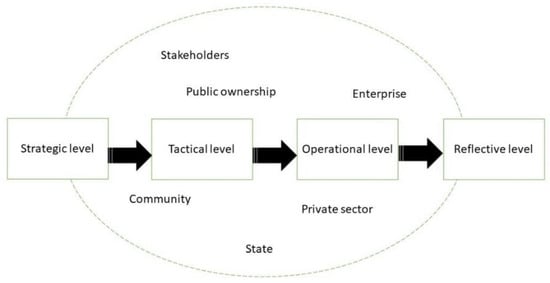
Figure 1.
Energy transition. Source: Author.
To understand the energy transition process, SC plays a key role in social change or as an explanation of why these developments do not occur in each context. Context sensitivity is precisely what has very often been criticised in the management of energy transition [1]. In this study, I would like to consider a particular insight that sees SC as a determining factor in being able to use this academic knowledge in different contexts. This research starts from the consideration that an energy transition process takes place in parallel with the sensitivity of society, which is of fundamental importance for the emergence and facilitation of energy transition processes. The management of energy transition could be considered as the theoretical aspect that characterises change, while SC, through research on its different indicators, aims at producing knowledge to facilitate energy transition.
What I want to point out is that, although SC is a term that has been in the literature for more than 30 years, there is no single view of it, which makes its conceptualisation very difficult. Juxtaposing these terms with something as new and changing as energy transition is something that can guide some energy interventions, but it risks creating a lot of confusion, as the indicators that are used are not always the same and, in some cases, are simply the result of an author’s interpretation based on some documents (ex: secondary data).
In the following section, I briefly address SC and how some of these indicators can influence the environmental choices that each person makes daily. It was not intended to take up the entire concept of SC, but only parts of it to get an overview before moving on to the next section. Section 2 describes how the literature was identified. Based on the identified literature, some elements that characterise the papers that have dealt with these issues are considered. The aim of this section is to have a broader overview of these two concepts to facilitate readers’ reflections, considerations, and methodologies that characterise the relationship between SC and energy transition in the social sciences. Section 3 explicates the goal of the research and the methodology used to identify the reference literature. Based on the identified literature, some elements that characterise the papers that have addressed the link between SC and energy transition are considered. The goal of this section is not to have an exhaustive view of these two terms but to be able to have a broader overview of these two concepts to facilitate readers’ reflections, considerations, and methodologies that can be applied to understand the relationship between SC and energy transition in the social science world. Section 4 considers some limitations of the present literature in the energy field in relation to some aspects and indicators characteristic of SC. Section 5 highlights some limits in this review and offers recommendations on what aspects of SC should be explored in energy transition in order to outline potentially fruitful paths for future research in the energy field.
2. Theoretical Framework of SC
There have been various criticisms of the development of the concept of SC over time, and even today, there is no single definition. Despite this, SC and its importance have never lost value. Putnam [11] sees it as a collective resource, where each individual comes into contact with the rest of society. Each member makes his or her own set of resources available to others in order to realise common projects that would not otherwise be feasible. SC is a system of shared norms, values, and beliefs embedded in social networks [12] and is characterised by cooperation, reciprocity, and trust, and it is said to improve social relations [13]. Subsequently, Coleman [14] defines it as a set of resources that the individual uses to achieve his or her goals. The networks of relationships that are created within society are the result of different types of social investment strategies that have the characteristic of creating and developing resources that can be spent over time. The interaction between the different members of a community, in fact, is durable and useful as it produces both material and symbolic profits. Coleman [14] attributes to SC the same characteristics of a public good, therefore usable by any social actor in that community.
Coleman [14], Bourdieu [15], and Portes [16] refer to an approach based on the calculation of the costs and benefits of an action. Bourdieu [15] was mainly concerned with using the concept of SC in the study of the analysis of social stratification. He defines SC as a resource for the achievement of individual strategies; its formation is linked to a deliberate action to achieve certain ends.
Subsequently, Portes [16] focuses on the formation of SC by referring to four processes: the internalisation of values, reciprocity exchanges, collective solidarity, and imposed trust.
An important aspect of SC is precisely the types of possible ties and types of trust, as they are linked to the behaviour of the individual and the acquisition of norms. Bonding bonds refer to relationships that occur within a community, characterised by the fact that the reference social group shares a common sense of identity. Bonding refers to relationships that occur within a community, characterised by the fact that the reference social group shares a common sense of identity. This concept can be found in individuals living in the same geographical area, where relationships are based on a well-localised level of trust that considers friends, relatives, and neighbours as social actors. Individuals with whom close-knit relationships are established usually share the same values, attitudes, and behaviours [17,18]. A negative effect that can occur in a predominantly bonding environment is a limitation on the part of the community to positively consider development and innovation processes, as relationships with individuals outside the network are limited. In fact, this type of bond is characterised by reinforcing the already existing social network by generating what Macias [19] defines as personal trust. Personal trust refers to the relationship we establish with the people we are in close contact with. In particular, at the housing level, it has been noted that a good connection between neighbours is positively correlated with environmental conservation actions and active participation in the community [20].
On the other hand, we find generalised trust. Macias [19] defines this type of trust as widespread confidence in the integrity of others even if we do not know them. In the field of environmental sustainability, studies show that generalised trust makes it more likely that people will actively engage in collaborating to preserve the environment in the confidence that others will do the same [19].
This kind of trust tends to create bridging ties, which specifically create ties outside the network by extending beyond the immediate community. Openness to the outside world allows the social actors involved to distance themselves from the behaviours and customs of the community of reference. This action is possible thanks to the moral support they receive from individuals outside the network with whom they have relationships.
This phenomenon is linked to the propensity of those with bridging ties to believe in and view social changes positively. This process is also favoured by the fact that these individuals receive more information than social actors who choose to have bonding ties, allowing them to have a broader view of social situations [18].
SC is a concept that has evolved over time and has taken on a multidisciplinary character. Different disciplines have used it to try to understand different issues, such as social tensions [21], social conflicts [22], local development [22,23,24], rural development [13], system development [25,26], etc. In the last 20 years, a new form of energy economy has arisen. Consequently, the concept of SC has been introduced to understand and explain some elements of energy transition. Rogers et al. [27] consider the level of SC as an essential element for the success of energy projects because it can influence their results. SC can make a difference in the growth of innovative energy companies [28]. Von Bock Und Polach et al. [20] stress that a good balance between collective activity and leadership can generate trusting relationships, ties, and community networks that foster the sustainable use of renewable energy. Yang et al. [29] highlights the influence of SC in active participation in initiatives that address energy change. Jordán et al. [18] identify a sense of community and SC as essential aspects for the success of energy projects that involve the community. Below, I will look at all the relationships between SC and energy transition highlighted in the literature.
3. A Conceptual Review of SC and Energy Transition
3.1. Objectives
The goal of this literature review is to explore how the concept of capital has been studied in the social science field in relation to energy transition. To this end, I will examine what dimensions of SC have been considered in energy-related research and identify which indicators of SC have been considered in energy transition. In this way, I will provide a broader view of the research conducted so far and provide insights into what characteristics, dimensions, and indicators of SC are important in order to better understand the role of the community in energy transition.
3.2. Methodology
This literature review has a two-pronged approach. Its first objective is to quantitatively assess changes in the intensity of research on the relationship between SC and energy transition, measured in terms of the volume of publications that have appeared over time. For this, I used two different databases, Scopus and ISI Web of Science. These two databases were chosen for two reasons. The first is that in recent years these two databases have been regarded as integrated, making it possible to merge the databases to create a single integrated analysis [30]. Secondly, both allow searches limited to “titles”, “abstracts”, and “keywords”. All articles containing the words “SC” and “energ*” were selected. The new search resulted in 143 articles (The research was conducted in October 2021). Only articles from the area of social sciences published between 2001 and 2021 were selected. Of these 143 articles, some were excluded for the following reasons: double in the two journals, the concept of energy was understood as “emotional energy”; in other cases, “SC” was confused with the word “Social Capitalism”. The total number of articles considered is 90.
The second objective is a more qualitative conceptual review that allows us to understand how these two concepts have been considered over time. Through the NVivo software, different codes were used to investigate different aspects of the articles. In particular, the geographical distribution of departments that dealt with this topic was considered, as well as the number of authors interested in these topics in the various departments. Subsequently, the publications by years were considered. The different indicators of SC considered in the articles and the methodological approach used were also considered.
After selecting papers, they were reviewed according to six aspects.
- Topic: I examined which fields have been most explored in studies of SC and energy transition. Which of these goals do researchers have in using SC to understand certain community attitudes? This aspect is important to understand what fields are mostly considered, how SC is explored, and what interpretations of the findings are made regarding the energy transition.
- Definition of SC: I explored how many terms are used to define SC and how they relate to specific indicators of SC [31]. For example, it is not easy to define what SC is, but very often, the level of SC is associated with specific aspects of it, such as relationships, trust, etc.
- SC dimensions: SC is composed of three dimensions: structural, relational, and cognitive [32]. In studies, particular importance is often given to the structural dimension, more to the relational and less to the cognitive. In doing so, there is the risk of neglecting important elements of SC in relation to energy transition.
- SC indicators: Because the term “SC” is difficult to define, we examined what elements were commonly included when discussing SC. There seems to be disagreement about which elements are necessary to understand SC. In fact, studies of it in the energy field have often included only a few indicators of SC.
- Methods used: I examined what methods were used to gather information about SC, primarily whether they were qualitative, quantitative, or mixed.
- Distribution of departments/Relations between authors in different countries: I explored the geographic area of departments that have explored the concept of SC and the collaborations between authors from different countries. This choice was made to see how the relationship between SC and energy transition was approached based on different cultural realities [1].
In the process of reviewing the literature, I identified two main journals that frequently consider at a theoretical and empirical level the relationship between SC and energy transition, Sustainability Switzerland and Energy Research and Social Science (Table 1). Most of the rest of my discussion revolves around the articles published in these journals.

Table 1.
Main journal (based on searches in ISI Web of Science and Scopus).
3.3. Results and Trends
The concept of SC and energy transition is developed in a broader context, particularly in journals dealing with sustainability issues and seeking to bring the energy field closer to and complement the social field.
Many authors working in very different contexts have looked into this relationship (Figure 2).
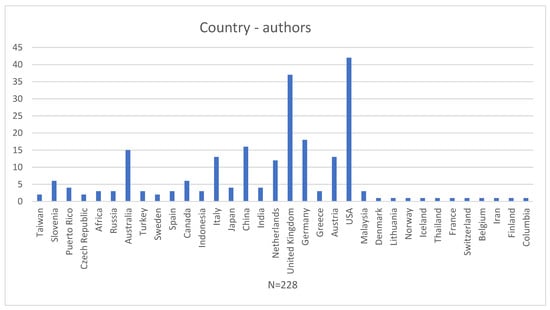
Figure 2.
Number of authors by country of scientific activity (location is based on the location of the institutions where authors were based, not the nationality of authors. If authors had multiple affiliations in different regions, the location of the author was divided between those regions).
As can be seen from the graph, the values are unevenly distributed, and few appear in places such as South America, where I find only one Colombian author [33] who has published a paper on this topic. This aspect is very interesting and relates to the considerations made by the authors Noboa and Upham [1]. The authors point out that the concept of energy transition is much discussed in Europe, where the regime is liberal-democratic, but little considered in other contexts, such as in South America, where there is an illiberal democratic regime that does not consider the participation of citizens in energy decisions. There are two different forms of government, a centralised and privatised form of political economy, for example, in Peru, Chile, and Colombia, where some international companies exploit natural resources related to energy. In other states, however, such as Venezuela, Ecuador, Bolivia, and Nicaragua, there has been a redistribution of resources, and management is in the hands of state-owned companies. What all forms of government have in common, however, is that ownership patterns and management of energy resources are controlled by a few actors and citizen participation is not contemplated. To facilitate a large-scale sustainable energy transition, the role of the community is important. In fact, projects that start from the bottom up allow achieving energy savings and changes in behaviour by the community that cannot be achieved through top-down policies [31]. Energy initiatives that start from the bottom are able to reach actors that other types of projects cannot [32]. This is precisely attributable to the SC that is generated among the different members of the community. The following figure (Figure 3) is a relational representation elaborated through the UCINET software and represents the collaborations between different countries for the writing of different articles.
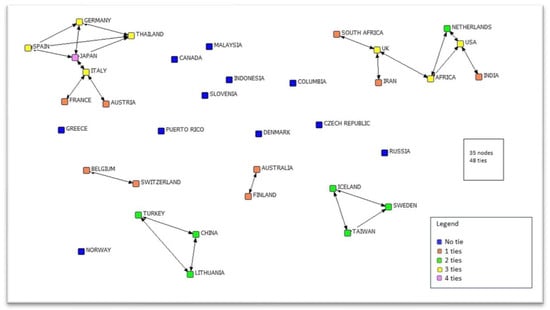
Figure 3.
Relations between authors in different countries. Source: Author.
In total, I found 35 nodes and 48 ties. Some countries, such as Denmark, Russia and Colombia, have not collaborated with other countries in writing articles on SC and energy transition. Japan appears to be the state that has the most relations with the outside world within the European context (Spain, Italy, and Germany). It is very interesting to see how other countries, despite not being geographically close, have built a network with other countries, such as the UK and Africa or the USA and India. This makes us understand that there is a willingness to collaborate even if the authors’ working contexts are very different. A collaboration that considers different contexts could help to deepen these two concepts giving a more global vision of the relationship between SC and energy transition. The following image (Figure 4) shows the location of the departments to which the authors who have worked on this topic are affiliated (If several authors of the same article collaborated in the same department, the department was only entered once anyway).
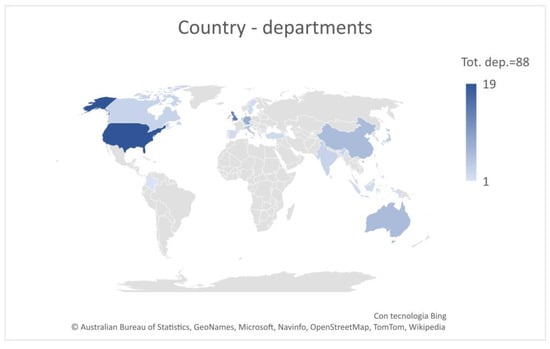
Figure 4.
Distribution of departments that have dealt with this topic.
As can be seen, there are states that have dealt with this issue more than others, in particular the United States (19 departments) and Great Britain (14 departments). The United States is an important pillar in the history of energy transition and, in particular, citizen participation in this process. In fact, some terms that identify precisely a change in the role of citizens in energy-related decision-making, such as “energy democracy”, originate in the United States [33]. In this context, it is also important to remember that the Aarhus Convention and UN policies in some countries, particularly in the UK and US, guide planning policies that ensure that public participation takes place with local communities in many projects such as low-carbon infrastructure [34]. These could be some of the reasons for these countries to contribute more to understanding the link and influence between SC and energy transition. The following graph (Figure 5) shows the papers published in the last 20 years on SC and energy transition (N = 90). The papers are distributed as follows.
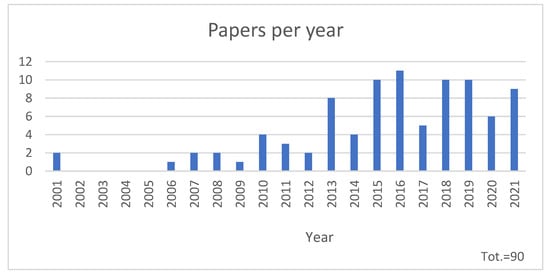
Figure 5.
Number of articles published per year from 2001 to 2021.
Publications began in 2001, followed by some very poor years on this topic until 2006, when publications began again. The peak years are 2013, 2015, and 2016, with a decline in 2017 and a recovery in the following years. Some of these years are particularly indicative of historical events on energy issues that may justify this trend. In particular, in 2012, there was the Doha Conference (COP 18) on climate change. In the European context (accounting for 33% of the departments dealing with these issues), many important regulations were introduced this year. In 2015, the European Commission published a new strategy (COM(2015)0080) with the aim of achieving an Energy Union that offers EU households and businesses a secure, sustainable, competitive, and more affordable energy supply. In 2016, the European Commission (COM(2016)0860) proposed a package consisting of 8 proposals promoting clean energy for all. Part of this package is renewable energy (UE) 2018/2001), introduced in 2018, and energy efficiency, also from the same year (UE) 2018/2002). All these elements help us to understand the connection between the years of these publications and the new regulations.
The following graph (Figure 6) shows the topics covered by the selected articles.
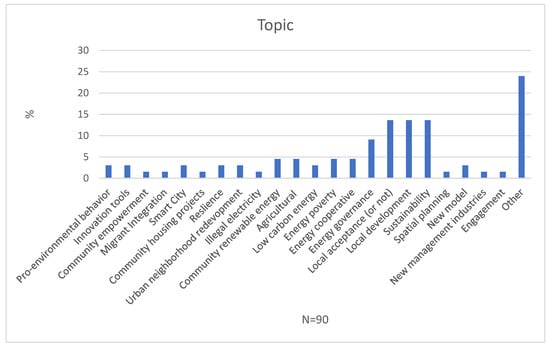
Figure 6.
Topic of articles considering “SC” and “energ*”.
SC is considered with reference to different topics. A number of authors [27,33,35,36,37] consider how SC could play an important role in the acceptance or non-acceptance of new energy practices (local acceptance (or not)), production processes, and the construction of renewable energy facilities. In particular, SC is seen as empowering in protests over new plants [35] or as facilitating transition and adaptation to change in certain contexts, such as rural ones [38]. The relationship aspect of SC is considered an element that fosters cohesion to achieve common goals [27,34,39].
Other authors [40,41,42] give importance to the technological and innovative aspects of energy and how new norms or values related to energy and its use can be compared to the development of SC. SC is considered a collective good derived from compliance with shared social norms that influences the socio-cultural acceptance of new energy technologies [40]. The relationship between residents can be a determining factor in the success of innovative energy interventions [41].
SC has also been considered in relation to sustainability [43,44,45,46,47] and in the development of new sustainable business models. Again, importance is given to the ability of SC to create networks both outside the target community [46] and within the community [47], consolidating and building both social and human capital. It is also considered one of the five factors that make up capital in its most general sense (physical, natural, human, financial, and SC). In particular, a high level of SC can foster relationships between communities and institutions by promoting energy change [44,45,46,47].
In other research, SC appears to be relevant in the creation of renewable energy co-operatives [48,49,50,51]. In this context of SC, its relational aspect and how these relationships within co-operatives can facilitate their development are explored.
SC is also related to energy poverty [11,24,52]. In this case, SC is considered in relation to socio-cultural aspects of specific contexts. Rogers et al. [27] refer to how neighbourly relations are important in spreading the importance of energy conservation and good energy use.
In other research, it has been seen as important in promoting environmental initiatives and actions [26,37,53]. SC is considered an important promoter in collective actions [53], and in general, in defence of common goods and ecosystem services [53].
In these studies, SC and a sense of community are considered important aspects of the success of energy projects [27] and the connection between these projects and socio-economic aspects, such as crime, which can be influenced by the level of SC [19]. Once again, the power of capital in facilitating collective actions is emphasised [54].
The different definitions of SC have been regrouped following the more important classifications of SC:
- Individual benefits of social capital: “Friends, colleagues, and more general contacts through whom you receive opportunities to use your financial capital and human capital” ([55]: 9);
- Group benefits of social capital: “Social capital flows from the endowment of mutually respecting and trusting relationships which enable a group to pursue its shared goals more effectively than would otherwise be possible” ([56]: 57);
- Unintentional result: “[] Social capital depends on being a byproduct of activities engaged in for other purposes” ([23]: 312);
- Actively created result: “Becker supposes that people choose social networks in ways that will maximise their utility” ([57]: 82).
The following figure (Figure 7) represents the frequency for each definition given to SC in articles in the energy field.
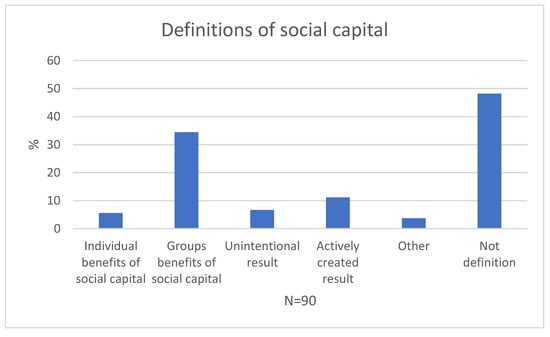
Figure 7.
Definitions of SC.
The graph shows that SC, in most cases, is considered to be an element that benefits the group. In fact, social networks are often referred to in the definition of SC. The network is considered a feature of the community, allowing people to be able to help each other in times of economic need [58]. Community-based initiatives are essential to address the need for renewable sources in some countries where non-renewable sources are not only not sustainable but also not sufficient [26]. In this situation, mobilising SC (actively created result) is seen as important for preserving the environment, although a more energy-conscious behaviour may not always lead to a more sustainable behaviour [6]. According to other authors, however, it is considered a facilitator, particularly in cooperation and collaboration for mutual benefit [41]. It is also interesting to note that almost half of the authors do not give a definition of SC (ex: [26]). This is because, in many cases, it is only introduced in the studies but not explored in depth. In energy transition, understanding the link between social and economic development is very important. Social networks and collaboration are elements that lead to social development, and energy in this context is a means for people to satisfy their daily, personal needs [46]. The individual aspect that characterises the link between energy and society is not reflected in the definitions used to define SC in the literature. Involving the community in the appropriate way within the transition process by considering the different facets of SC leads to two types of benefits, it favours economic development, as energy is fundamental for production [59], and the availability of energy increases social happiness, just think of the possibility of heating one’s own flat [46].
The next graph (Figure 8) shows the three dimensions of SC [18] that are considered in the articles.
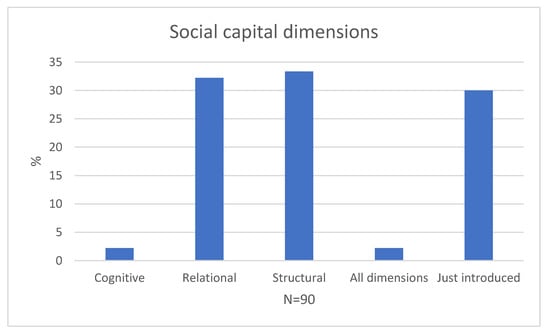
Figure 8.
SC dimensions.
From Figure 8, the two dimensions of SC that are considered are relational and structural. This is linked to what was previously considered in the definition of SC. In fact, the structural dimension refers to the network within the community. In order to address the characteristics of SC and to provide a shared model, SC was usually divided into two dimensions, structural and relational, which in some cases were confused, such as in the work of Nyqvist et al. [60], who classify some indicators of SC that belong to the relational dimension to the cognitive dimension. Nyqvist et al. [60], in fact, consider structural SC as “networks, relationships, and institutions that connect people and groups” [61], quantification of network ties and group participation, and cognitive SC, which refers to “values, attitudes, trust, confidence, and norms”, measured through more subjective characteristics. In particular, the structural dimension refers to what people do in their social life, while the cognitive dimension refers to how people feel about their social life [29]. Only three of the articles of the literature review within their research take into account all three dimensions. This is an aspect that is also highlighted in the paper of Broska [6], which highlights the lack of the three dimensions of SC in all studies that link SC to pro-environmental behaviours. In some of the articles, the concept of SC was only introduced but not further explored, and therefore, it was not possible to identify one or more of the dimensions of SC.
The following graph (Figure 9) shows the indicators that are considered within the papers and the indicators that are measured. The same indicators used by Claridge [62] were considered for each dimension of social capital (The X-axis shows the three dimensions of the SC and the distribution of data for each indicator, numbers are useful for understanding how many indicators exist for each dimension of SC).

Figure 9.
The different indicators used to measure SC.
From Figure 9, the network indicator is the most often considered. Followed by trust and ties, these indicators are part of the structural and relational dimensions. An interesting aspect that could explain this gap between the introduction and use of these indicators is that very often, SC is not actually measured with specific questions but is only used as an element that can explain certain phenomena (see: [63]). The network in Balfour and Alter’s [64] research was used to identify critical actors in the community; the results of this analysis were considered important in understanding the dynamics within the community. The same article by Broska [6] considers, in the initial part of his article, the three dimensions of SC. The empirical part of his research does not consider explicit questions on some of these indicators but is the result of an interpretation of the results of the interviews. The cognitive dimension is considered an important indicator of SC by some authors [40,62], but no method is used to be able to qualitatively or quantitatively understand this indicator. Another element that could also explain this gap between the elements considered and those measured is that in some articles (ex: [40]), some indicators such as trust, considered important as an indicator in the next stage of analysis, are explained using networks. An interesting aspect of indicators is that there are usually positive and negative aspects to SC, but usually, in the various research, the former is considered while the latter remains unknown [50]. The following graphs (Figure 10 and Figure 11) represent the methods that were used to collect the data in the various studies (The total number of research considered in these graphs is 50, the remaining 40 articles have not been considered because they are not empirical research or secondary data were used (12 articles) that cannot be entered in either method.) From Graph 10, there are different types of methods used to collect data.
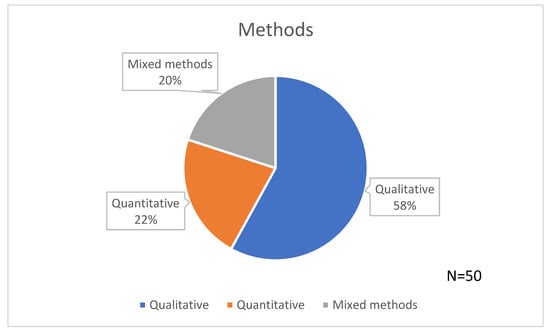
Figure 10.
Methods used to investigate SC.
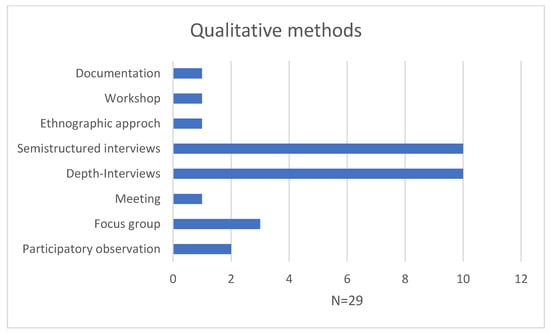
Figure 11.
Qualitative methods used.
In most cases, the methods used are qualitative (58%) (see: [6,58]), in others, quantitative (22%) (see: [53,58]), and to a lesser extent, mixed method (20%) ([19,45]) (The different methods for data collection and data modelling are important because they might affect the results in primary studies. This aspect, however, should not affect my review because I concentrate on a descriptive analysis of the research available online and don’t look for statistical differences across studies.) Usually, in empirical research concerning SC, a qualitative approach is chosen.
The method used in quantitative research is a survey.
In addition, most of the research (12) used secondary data to explore the relationship between SC and energy (ex: [41,43]). This relates to what is shown in Figure 6, where socio-demographic or crime data appear among the indicators of SC. As far as the questionnaires are concerned, these were usually conducted by telephone, and the sample is not representative but only includes those who agreed to be interviewed. Rogers et al. [27], on the other hand, refer to a tool created by the World Bank that has conducted extensive work on the development of methods and indices to measure SC. In particular, the SC Thematic Group within the World Bank has two tools for assessing SC, the SC Assessment Tool (SOCAT) and the SC Integrated Questionnaire (SOCAPIQ). SOCAT is a tool designed to collect information on SC at the household and community organisational level. The second tool, SOCAPIQ, is more quantitative and can be added to existing family questionnaires and is the one used by Rogers et al. [27] in their study.
Figure 9 (The names of the methods have been given as they appear in the articles so as not to alter their meaning.) (Figure 11) shows the qualitative methods used to examine data.
There are several methods that are used to collect data, the most used being semi-structured interviews and in-depth interviews. In some research [9,60], data are collected with qualitative methods such as in-depth interviews or documentation concerning the local reality, but in a later stage of analysis, quantitative methods are used in which the authors analyse the data. Anderson and Schirmer [55] used a qualitative approach using semi-structured interviews, as did Atwell et al. [65] and Bereményi et al. [58]. Haque et al. [43] and Perez-Sindin [21] used a qualitative method but included focus groups in addition to the semi-structured interview. In some cases, the participatory observation method was used [40,49].
The following graph (Figure 12) (The total number of articles in this chart is 93 and not 90 as the number of articles selected because 3 of the articles refer to both renewable and non-renewable energy (i.e., nuclear and photovoltaic);) (Non-renewable energies to be included in these categories have been selected in accordance with US Department of Energy (Energy Sources | Department of Energy);) (The categories eco city and smart city have been included in the same category, because in this study I was interested in the social and environmental aspect that both have in common: they share the aspirations of reducing environmental loads and improving human welfare (www.ecocitystandards.org: access 17 May 2022);) considers the different types of energy or energy sustainability that are considered in SC research.
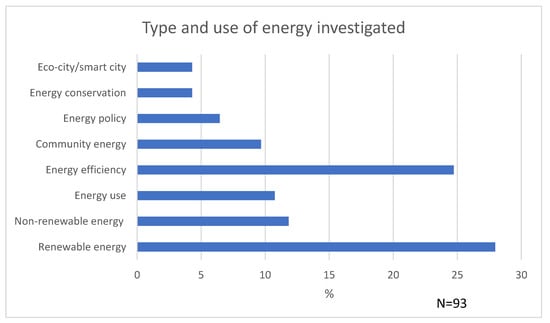
Figure 12.
Energy investigated.
As can be seen from Figure 12, there are several energy topics where the SC concept is introduced. The field where it has been most used is renewable energy, where the percentage is 28%. These articles look at renewable energy as a whole and community interaction as a very important aspect of the adoption of this type of energy. SC plays a very important role in this type of research because it is very often related to sustainable practices within households [45,64] and the use of renewable energy [66]. An interesting aspect that is not possible to see from the graph is that, among the selected articles, only one refers to biomass, which we find in the renewable energy category, namely, The Efficiency of Biomass Energy Management with Local Resource Management Potential [67]. Probably all the articles that deal with biomass are not found in the social science part of the journals but in the environmental ones, which I will not go into in this article. The article by Hu et al. [49] introduces a ‘hub-and-spoke’ model of eco-cities [68] (clusters of small and medium-sized cities around larger ones) designed to make China an international pioneer in eco-city development. This approach used is called top-down. An interesting aspect of this study is the role attributed to the community. Identity aspects such as community acceptance and cultural rootedness are only considered in the final stage of this approach. Instead, great emphasis is placed on the institutional role, macro-level policies, and the implementation of laws. The aspect that makes this study misleading is the idea that instead of humans, society is the essential part of the city. Excluding the community from the entire initial design phase in this approach makes the characteristics of society and social capital marginal.
Renewable energy is becoming an increasingly important topic, and its continued growth is progressing at a very high level. In fact, 260 GW of renewable energy was planned to be installed globally in 2020 [69]. Moreover, renewable energy represents the cheapest source of energy in most of the world; even coal-fired power plants are now more expensive than renewable energy [70], in addition to being more harmful to the environment.
4. Problems and Controversies
What can be seen from this literature review is that the concept of SC in the energy field and beyond is very difficult to delineate. This aspect generally characterises many concepts in the social sciences, which is not necessarily seen in a negative way. As SC is a very broad concept and has also been studied for a long time, it might be plausible that there is no single definition of this term. In particular, as already suggested for other terms [5], it might be useful to move away from the definition of the concept and focus on those SC indicators that connect with energy transition or on the presence in different contexts of these specific indicators. What follows are the different discourses in the literary world regarding the characteristics of SC, linking it to a process such as energy transition. How do the different disciplines dealing with these topics create confusion or clarity? Is SC the result of social or personal characteristics? Are there variables or factors that influence SC? What are the indicators of SC that can influence energy transition?
4.1. Features of SC
To date, there is no single definition of this term, although we often start with the classic definition given by Putnam [11] and Coleman [14] and move on to new interpretations such as Macias [14], who have made this concept increasingly dense.
From the analysis of the articles, some characteristics of SC emerged that create a division in the interpretation of this term. Some consider it as a fixed resource ([19,65]) present in the community, while others consider it as a flexible element that can be modified [42,64,71]. To date, the flexible characteristic of SC is the most dominant one, which leads many authors to use some terms that indicate a transformation linked to this concept, such as “development of SC” or “creation of SC”. However, what is missing in considering SC as something that changes are the practical actions that can lead to this development or creation, in reference to which the literature remains very vague. In some cases, SC is considered as a support [72] or facilitator of energy transition processes [66,73], but even in this case, the considerations often remain generic and do not provide tools to use SC for this purpose.
These different characteristics of social capital in relation to energy transition reflect the classical division in the view of social capital. In fact, there are usually two different camps, those who consider social capital as an unintentional result [56] and other researchers dealing with social capital who consider it as actively created and fostered by social relations.
4.2. SC, Social or Individual Interaction?
The SC is, perhaps because of its name, considered in almost all studies as something related to society, considering how the individual interacts with society through values, norms, and relationships. Only a few authors, three, consider an individual aspect of SC, such as the experience and motivation that creates what is referred to in SC as identity. Personal motivation drives people to take part in sustainable community projects, committing to environmentally friendly behaviours [6]. The characteristics of individual SC also play an important role in sustainable energy initiatives; in fact, the implementation of technologies, if accompanied by a strong individual and family network, can have an immediate and very strong impact on fossil energy consumption and greenhouse gas emissions [13]. Sustainable community projects that aim to create only collective actions can be disadvantageous while combining an individual and family level in these projects can have very positive feedback. Knowledge, which in fact, is a very important element of SC, is one of those aspects that exist only within the individual [74]. In my view, the individual aspect of SC, i.e., the wealth of experience and motivation that drives a person to take part in energy transition and to perform concrete actions, should be explored in greater depth.
4.3. SC, Positive or Negative Aspect?
SC is considered something positive for the community, and in contexts where it is not present or not so developed, it is important to create it through relationships and trust [75]. This idea, however, does not differentiate between those indicators of SC, such as personal trust or territorial identity, which, if developed further, could go against energy transition precisely because of their characteristics and the sense of community they create. With reference to this point, which very often sees SC as a big bag that contains several indicators that do not have a fixed or shared distribution, no author, except one, considers the three dimensions of SC that are nowadays recognised and shared in most of the world of sociological sciences, in his analysis. What I think should be done to make the best use of this concept and to help to define it is to consider what are the essential indicators that must be considered to talk about SC and to suggest practical actions to be able to understand, develop, and/or create it. In relation to energy transition, each indicator should be considered in more detail with the aim of giving a clearer view of which SC indicators favour energy transition in order to develop them, and which ones limit it in order to control them.
Only through an in-depth and shared study of what SC is and its relation to energy transition can this tool support this process, giving added value to all the research that in the last 20 years has dealt with these issues.
5. Limits
This article describes studies conducted over the past two decades that analyse the relationship between SC and energy transition. Some features, such as the dimensions of SC, the definition, and the methods used, aim to increase the understanding of SC in the energy field and help research in this area. This article elaborates some limitations, which can be overcome in future research for better results:
- Keywords in the article, abstract, and title were used to select papers. There might be some articles, however, that consider other keywords such as “social network analysis” and therefore do not consider “SC” and “energ*”, but that could have been relevant to this study;
- This study selected studies in the field of social sciences, but in the last decades, environmental sciences have also dealt with SC, but that was not considered in this article;
- An attempt was made to cover as many research articles as possible, but it is possible that some research articles which focus on the relationship between SC and energy may be missing. Likewise, the taxonomy parameters adopted in this research could be improved.
6. Conclusions
The concept of SC has evolved over time and has slowly been used in different contexts to understand phenomena and facilitate a process, as in the case of energy transition. In recent years, the terms SC and energy transition have become increasingly used, and several disciplines have stressed the role of citizens in defeating climate change and decarbonisation, in particular, their social characteristics and their social factors, considered important elements in these environmental changes.
The literature review regarding SC and energy transition found that studies and research conducted so far have not fully considered the three dimensions of SC: structural, relational, and cognitive [32,75,76].
The fact that these studies have focused only on the structural and relational dimension of SC, and therefore on relationships and trust, has led to highlighting the positive role of SC within energy transition. In fact, as highlighted by various studies, trust, relationships, etc., support transition processes, but there are also some aspects of SC that limit energy transition and that have been little considered in the research conducted so far. In particular, the cognitive dimension, which are individual characteristics that bind a person to their territory, defined as shared understandings that enclose a set of aspects that unite the inhabitants, such as values, codes, and narratives, and that attribute peculiarities to the territory itself. In the energy field, considering this aspect within energy transition is of fundamental importance because this transition process brings with it many changes that can affect places considered important by the inhabitants.
This passage also includes place meaning that has various aspects that tie a person to their place of origin, from a historical point of view and, especially, from an individual point of view [6]. Place meaning [18] encompasses a dual aspect that characterises an individual, their social reality, and their personal reality [77]. Place attachment generates an emotional bond between individuals and/or groups and familiar places. It is a complex phenomenon that usually generates a positive, though sometimes ambivalent or negative, bond [78]. Very often, identity and place attachment have been considered elements that relate to each other. Individuals, in fact, seek out typically natural places, which give the possibility of psychological restoration and become the most loved places [79].
Considering all these aspects in order to make the European Commission’s new strategy of increasing energy from renewable sources to 40 per cent feasible is of fundamental importance. In this context, territorial identity has a very important role to play in facilitating or limiting interventions, including technological ones, that can alter the landscape, change places, or ask the community to change their traditions and their history.
The implementation of a solar panel in a specific place, for people who do not live there, has no value whatsoever, but is seen only as an ecological transition. For the locals, it might be perceived differently. If the place where the solar panel is installed is a place with a high level of place meaning, it can lead to the failure of a project if the implementation does not consider this aspect. For example, conflicts can arise between the community and the project managers. Contradictions between project and place can be experienced by the community as a threat to their identity, provoking negative attitudes towards projects [79]. Despite the existing relationship between identity and place attachment, there is little research (ex: [71,80]) that has empirically examined the links between place attachment and support for a renewable energy project. Capturing all this information previously through SC knowledge is extremely important to avoid the occurrence of those phenomena named by Durkheim anomie [81] that lead to the disintegration of social norms and values associated with abrupt changes in the life of the community as a result of processes such as the industrial revolution in the past, and energy transition today [21].
Another aspect that emerges from this analysis is the lack of a methodology to better understand SC. This results in countless definitions of SC and its relation to energy transition, a relationship which, in some cases, becomes very reductive because it is associated with the simple social network created within the community.
Future research needs to further clarify the concept of SC in the energy field, including the different indicators and all three dimensions that comprise it, exploring in more detail which of these indicators can positively or negatively influence energy transition. In particular, the concepts behind the SC indicators should be unravelled to understand how each of them can change the community. The most important challenge for researchers in this field will be to understand which dimensions of SC add value to the transition and which dimensions need to be reduced for the community to positively approach all the changes that energy transition brings.
This requires researchers to consider each dimension of SC and use a similar methodology to operationalise the SC. The dimensions and methodology should be explored through theoretical and empirical research in this field. Researchers should pay particular attention to all the social characteristics that characterise a community and influence SC. All these characteristics and methodologies should be shared and used in all disciplines that deal with understanding energy transition through SC.
Funding
This research received no external funding.
Institutional Review Board Statement
Not applicable.
Informed Consent Statement
Not applicable.
Data Availability Statement
Requests to access the datasets should be directed to author.
Acknowledgments
The author thanks Jessica Balest for the numbers of feed-backs given during the writing of this paper, for the support in the implementation and discussion of the various parts of the paper, and Natalia Magnani for her help and suggestions during the development of this paper. The author thanks the Department of Innovation, Research and University of the Autonomous Province of Bozen/Bolzano for covering the Open Access publication costs.
Conflicts of Interest
The author declare that she has no known competing financial interests or personal relationships that could have appeared to influence the work reported in this paper.
References
- Noboa, E.; Upham, P. Energy policy and transdisciplinary transition management arenas in illiberal democracies: A conceptual framework. Energy Res. Soc. Sci. 2018, 46, 114–124. [Google Scholar] [CrossRef]
- Sovacool, B.K. How long will it take? Conceptualizing the temporal dynamics of energy transitions. Energy Res. Soc. Sci. 2016, 13, 202–215. [Google Scholar] [CrossRef]
- Xie, L.; Zhou, O. What improves subjective welfare during energy transition? Evidence from the clean heating program in china. Energy Build. 2021. [Google Scholar] [CrossRef]
- Delbeke, J.; Runge-Metzger, A.; Slingenberg, Y.; Werksman, J. The paris agreement. In Towards a Climate-Neutral Europe; Routledge: London, UK, 2019; pp. 24–45. [Google Scholar] [CrossRef]
- Trombin, M.; Pinna, R.; Musso, M.; Magnaghi, E.; de Marco, M. Mobility Management: From Traditional to People-Centric Approach in the Smart City. In Emerging Technologies for Connected Internet of Vehicles and Intelligent Transportation System Networks; Springer International Publishing: Cham, Switzerland, 2020; Volume 242. [Google Scholar] [CrossRef]
- Broska, L.H. It’s all about community: On the interplay of social capital, social needs, and environmental concern in sustainable community action. Energy Res. Soc. Sci. 2021, 79, 102165. [Google Scholar] [CrossRef]
- Pidgeon, N.; Demski, C.; Butler, C.; Parkhill, K.; Spence, A. Creating a national citizen engagement process for energy policy. Proc. Natl. Acad. Sci. USA 2014, 111, 13606–13613. [Google Scholar] [CrossRef] [PubMed]
- Silver, H.J. The social sciences and a new administration. Society 2008, 45, 422–424. [Google Scholar] [CrossRef]
- Warbroek, B.; Hoppe, T.; Bressers, H.; Coenen, F. Testing the social, organizational, and governance factors for success in local low carbon energy initiatives. Energy Res. Soc. Sci. 2019, 58, 101269. [Google Scholar] [CrossRef]
- Smith, A. Translating sustainabilities between green niches and socio-technical regimes. Technol. Anal. Strateg. Manag. 2007, 19, 427–450. [Google Scholar] [CrossRef]
- Putnam, R. Making Democracy Work: Civic Traditions in Modern Italy; Princeton University Press: Princeton, NJ, USA, 1993. [Google Scholar]
- Forbes, K.F.; Zampelli, E.M. Volunteerism: The Influences of Social, Religious, and Human Capital. Nonprofit Volunt. Sect. Q. 2014, 43, 227–253. [Google Scholar] [CrossRef]
- Morrison, C.; Ramsey, E. Power to the people: Developing networks through rural community energy schemes. J. Rural Stud. 2019, 70, 169–178. [Google Scholar] [CrossRef]
- Coleman, J.S. Social Capital in the Creation of Human Capital. Am. J. Sociol. 1988, 94, S95–S120. [Google Scholar] [CrossRef]
- Bourdieu, P. The form of capital. In Handbook of Theory and Research for the Sociology of Education; Greenwood: Westport, CT, USA, 1986; pp. 241–258. [Google Scholar]
- Portes, A. Social Capital: Its Origins and Applications in Modern Sociology. Annu. Rev. Sociol. 1998, 24, 1–24. [Google Scholar] [CrossRef]
- Weil, B. Solar city, bike city, growth city: Governance and energy in Davis, California. J. Polit. Ecol. 2013, 20, 137–158. [Google Scholar] [CrossRef][Green Version]
- Smith, J.W.; Anderson, D.H.; Moore, R.L. Social Capital, Place Meanings, and Perceived Resilience to Climate Change. Rural Sociol. 2012, 77, 380–407. [Google Scholar] [CrossRef]
- Macias, T. Risks, Trust, and Sacrifice: Social Structural Motivators for Environmental Change. Soc. Sci. Q. 2015, 96, 1264–1276. [Google Scholar] [CrossRef]
- Von Bock Und Polach, C.; Kunze, C.; Maaß, O.; Grundmann, P. Bioenergy as a socio-technical system: The nexus of rules, social capital and cooperation in the development of bioenergy villages in Germany. Energy Res. Soc. Sci. 2015, 6, 128–135. [Google Scholar] [CrossRef]
- Perez-Sindin, X.S. Are energy megaprojects socially disruptive? Assessing the impacts of the As Pontes fossil fueled power plant in Spain. Energy Res. Soc. Sci. 2021, 80, 102229. [Google Scholar] [CrossRef]
- Sumkoski, G. Towards socio-economic theory and practice of regulation. Evidence from OECD countries and Bangladesh. Cogent Soc. Sci. 2016, 2. [Google Scholar] [CrossRef]
- Felice, E. Regional development: Reviewing the Italian mosaic. J. Mod. Ital. Stud. 2010, 15, 64–80. [Google Scholar] [CrossRef]
- Huruta, A.D.; Kundhani, E.Y.; Manurung, C.R. The development of village-owned enterprises: Lessons learned from Ponggok Village. Masy. Kebud. Polit. 2020, 33, 77–86. [Google Scholar] [CrossRef]
- Frantál, B.; Nováková, E. On the spatial differentiation of energy transitions: Exploring determinants of uneven wind energy developments in the Czech Republic. Morav. Geogr. Rep. 2019, 27, 79–91. [Google Scholar] [CrossRef]
- Devkota, S.R. Energy input-output model for sustainable socio-economic development in Nepal. J. Resour. Energy Dev. 2007, 4, 1–16. [Google Scholar] [CrossRef]
- Rogers, S.H.; Halstead, J.M.; Gardner, K.H.; Carlson, C.H. Examining Walkability and Social Capital as Indicators of Quality of Life at the Municipal and Neighborhood Scales. Appl. Res. Qual. Life 2011, 6, 201–213. [Google Scholar] [CrossRef]
- Kjeldsen, C.; Svensen, G.L.H. Networking private entrepreneurs in rural areas—Social capital or waste of time? Ager 2011, 11, 7–28. [Google Scholar]
- Yang, T.; Long, R.; Li, W.; Rehman, S.U.R. Innovative application of the public-private partnership model to the electric vehicle charging infrastructure in China. Sustainability 2016, 8, 738. [Google Scholar] [CrossRef]
- Caputo, A.; Kargina, M. A user-friendly method to merge Scopus and Web of Science data during bibliometric analysis. J. Mark. Anal. 2021, 10. [Google Scholar] [CrossRef]
- Yeung, S.; Rosenberg, M.; Banach, D.; Mayotte, L.; Anand, S.S.; Band, L.L.R.I.; Nation, F.M.F.; Castleden, H. Bonding social capital and health within four First Nations communities in Canada: A cross-sectional study. SSM-Popul. Health 2021, 16, 100962. [Google Scholar] [CrossRef]
- Seliverstova, N.S.; Iakovleva, E.L.; Grigoryeva, O.V.; Vorontsova, L.V. Dimensions of social capital. Actual Probl. Econ. Law 2018, 12, 2000–2003. [Google Scholar] [CrossRef]
- Polanco, J.A. Exploring governance for sustainability in contexts of violence: The case of the hydropower industry in Colombia. Energy Sustain. Soc. 2018, 8, 39. [Google Scholar] [CrossRef]
- Servillo, L.; Atkinson, R.; Smith, I.; Russo, A.; Sýkora, L.; Demazière, C. TOWN Small and Medium Sized Towns in their Functional Territorial Context—Inception Report; European Union: Brussels, Belgium, 2012; p. 47. [Google Scholar]
- Steward, F.; Liff, S.; Dunkelman, M. Mapping the Big Green. Current 2009. Available online: https://www.nesta.org.uk/report/mapping-the-big-green-challenge/ (accessed on 19 June 2022).
- Szulecki, K.; Overland, I. Energy democracy as a process, an outcome and a goal: A conceptual review. Energy Res. Soc. Sci. 2020, 69, 101768. [Google Scholar] [CrossRef]
- Satoh, K.; Weiss, T. Vertical and Horizontal Networks Revisited: Exploring Their Effects on Attitudes and Advocacy Toward Nuclear Energy. Soc. Sci. Jpn. J. 2021, 24, 85–113. [Google Scholar] [CrossRef]
- Knudsen, S. Is Corporate Social Responsibility Oiling the Neoliberal Carbon Economy? Ethnos 2018, 83, 505–520. [Google Scholar] [CrossRef]
- Scheffran, J.; Marmer, E.; Sow, P. Migration as a contribution to resilience and innovation in climate adaptation: Social networks and co-development in Northwest Africa. Appl. Geogr. 2012, 33, 119–127. [Google Scholar] [CrossRef]
- Parkhill, K.A.; Shirani, F.; Butler, C.; Henwood, K.L.; Groves, C.; Pidgeon, N.F. ‘We are a community [but] that takes a certain amount of energy’: Exploring shared visions, social action, and resilience in place-based community-led energy initiatives. Environ. Sci. Policy 2015, 53, 60–69. [Google Scholar] [CrossRef]
- Tilt, B.; Gerkey, D. Dams and population displacement on China’s Upper Mekong River: Implications for social capital and social–ecological resilience. Glob. Environ. Chang. 2016, 36, 153–162. [Google Scholar] [CrossRef]
- Exner, A.; Politti, E.; Schriefl, E.; Erker, S.; Stangl, R.; Baud, S.; Warmuth, H.; Matzenberger, J.; Kranzl, L.; Paulesich, R.; et al. Measuring regional resilience towards fossil fuel supply constraints. Adaptability and vulnerability in socio-ecological Transformations-the case of Austria. Energy Policy 2016, 91, 128–137. [Google Scholar] [CrossRef]
- Haque, A.N.; Lemanski, C.; de Groot, J. Why do low-income urban dwellers reject energy technologies? Exploring the socio-cultural acceptance of solar adoption in Mumbai and Cape Town. Energy Res. Soc. Sci. 2021, 74, 101954. [Google Scholar] [CrossRef]
- Cirman, A.; Mandič, S.; Zorić, J. Decisions to Renovate: Identifying Key Determinants in Central and Eastern European Post-socialist Countries. Urban Stud. 2013, 50, 3378–3393. [Google Scholar] [CrossRef]
- Winskel, M.; Mcleod, A.; Wallace, R.; Williams, R. Energy Policy and Institutional Context: Marine Energy Innovation Systems. Sci. Public Policy 2006, 33, 365–376. [Google Scholar] [CrossRef]
- Qi, W.; Huang, Z.; Dinçer, H.; Korsakiené, R.; Yüksel, S. Corporate governance-based strategic approach to sustainability in energy industry of emerging economies with a novel interval-valued intuitionistic fuzzy hybrid decision making model. Sustainability 2020, 12, 3307. [Google Scholar] [CrossRef]
- Nilsson, A.E.; Larsen, J.N. Making regional sense of global sustainable development indicators for the Arctic. Sustainability 2020, 12, 1027. [Google Scholar] [CrossRef]
- Chen, H.; Zhu, T.; Krott, M.; Calvo, J.F.; Ganesh, S.P.; Makoto, I. Measurement and evaluation of livelihood assets in sustainable forest commons governance. Land Use Policy 2013, 30, 908–914. [Google Scholar] [CrossRef]
- Hu, M.C.; Wu, C.Y.; Shih, T. Creating a new socio-technical regime in China: Evidence from the Sino-Singapore Tianjin Eco-City. Futures 2015, 70, 1–12. [Google Scholar] [CrossRef]
- Straka, C. Local energy policy and smart growth. Local Environ. 2002, 7, 453–458. [Google Scholar] [CrossRef]
- Herbes, C.; Rilling, B.; Holstenkamp, L. Ready for new business models? Human and social capital in the management of renewable energy cooperatives in Germany. Energy Policy 2021, 156, 112417. [Google Scholar] [CrossRef]
- Brummer, V. Of expertise, social capital, and democracy: Assessing the organizational governance and decision-making in German Renewable Energy Cooperatives. Energy Res. Soc. Sci. 2018, 37, 111–121. [Google Scholar] [CrossRef]
- Abdallah, S.; Bressers, H.; Clancy, J. Potential electricity co-operatives in Kenya: Could social capital be a barrier? Community Dev. J. 2015, 50, 213–228. [Google Scholar] [CrossRef]
- Mishra, S.N. Issues before Evolving Energy Cooperative: Field Note from Leh, India. Int. J. Rural Manag. 2013, 9, 209–216. [Google Scholar] [CrossRef]
- Anderson, C.; Schirmer, J. Why and How Urban Residents Resisted a Proposed Gas-Fired Power Station. Urban Policy Res. 2015, 33, 324–339. [Google Scholar] [CrossRef]
- Bauwens, T.; Defourny, J. Social Capital and Mutual Versus Public Benefit: The Case of Renewable Energy Cooperatives. Ann. Public Coop. Econ. 2017, 88, 203–232. [Google Scholar] [CrossRef]
- Chen, Q.; Acey, C.; Lara, J.J. Sustainable futures for Linden Village: A model for increasing social capital and the quality of life in an urban neighborhood. Sustain. Cities Soc. 2015, 14, 359–373. [Google Scholar] [CrossRef]
- Bereményi, B.Á.; Montero-Díaz, E. Crisis hipotecaria, capital social y empoderamiento: Una exploración a partir del caso de la Plataforma de Afectados por la Hipoteca (PAH). Arbor 2019, 195, a518. [Google Scholar] [CrossRef]
- Valente, A.; Iribarren, D.; Dufour, J. Harmonised carbon and energy footprints of fossil hydrogen. Int. J. Hydrog. Energy 2021, 46, 17587–17594. [Google Scholar] [CrossRef]
- Nyqvist, F.; Pape, B.; Pellfolk, T.; Forsman, A.K.; Wahlbeck, K. Structural and Cognitive Aspects of Social Capital and All-Cause Mortality: A Meta-Analysis of Cohort Studies. Soc. Indic. Res. 2014, 116, 545–566. [Google Scholar] [CrossRef]
- Ahmad, P.; Yusof, F.; Abdullah, F. Local Economic Growth and Community Sustainability. Procedia-Soc. Behav. Sci. 2013, 101, 437–444. [Google Scholar] [CrossRef]
- Claridge, T. Designing Social Capital Sensitive Participation. Social Capital Research 2004. Available online: https://www.socialcapitalresearch.com/wp-content/uploads/2013/01/Social-Capital-and-Participation-Theories.pdf (accessed on 19 June 2022).
- Burt, R.S. Structural Holes: The Social Structure of Competition; Harvard University Press: Cambridge, UK, 1992. [Google Scholar]
- Balfour, B.; Alter, T.R. Mapping community innovation: Using social network analysis to map the interactional field, identify facilitators, and foster community development. Community Dev. 2016, 47, 431–448. [Google Scholar] [CrossRef]
- Atwell, R.C.; Schulte, L.A.; Westphal, L.M. How to build multifunctional agricultural landscapes in the U.S. Corn Belt: Add perennials and partnerships. Land Use Policy 2010, 27, 1082–1090. [Google Scholar] [CrossRef]
- Petropoulou, E.; Petousi, V.; Theodorakopoulou, I. To cultivate or not to cultivate? An exploratory analysis of what influences greek farmers’ decisions towards the cultivation of bioenergy crops. In World Sustainability Series; Springer: Cham, Switzerland, 2018; pp. 435–455. [Google Scholar] [CrossRef]
- Lin, Y.; Jim, C.Y.; Deng, J.; Wang, Z. Urbanization effect on spatiotemporal thermal patterns and changes in Hangzhou (China). Build. Environ. 2018, 145, 166–176. [Google Scholar] [CrossRef]
- McKinsey &, Co. Preparing for China’s Urban Billion. McKinsey Glob. Inst., No. March, 1–540, 2009.
- IRENA. Renewable Capacity Statistics 2016 Statistiques de Capacité Renouvelable 2016 Estadísticas de Capacidad Renovable 2016; IRENA: Abu Dhabi, United Arab Emirates, 2016. [Google Scholar]
- IRENA. Renewable Power Generation Costs in 2020; IRENA: Abu Dhabi, United Arab Emirates, 2020. [Google Scholar]
- Devine-Wright, P.; Fleming, P.D.; Chadwick, H. Role of social capital in advancing regional sustainable development. Impact Assess. Proj. Apprais. 2001, 19, 161–167. [Google Scholar] [CrossRef]
- Wächter, P. The impacts of spatial planning on degrowth. Sustainability 2013, 5, 1067–1079. [Google Scholar] [CrossRef]
- Kawamoto, K. The efficiency of biomass energy management with local resource management potential. Stud. Reg. Sci. 2015, 44, 327–338. [Google Scholar] [CrossRef]
- Macias, T. Convergent links of social capital, sustainable practices, and support for cost-specified climate policy in two Vermont and Arizona Counties. Environ. Sociol. 2016, 2, 220–232. [Google Scholar] [CrossRef]
- Yurtseven, Ç. The causes of electricity theft: An econometric analysis of the case of Turkey. Util. Policy 2015, 37, 70–78. [Google Scholar] [CrossRef]
- Nahapiet, J.; Ghoshal, S. Social capital, intellectual capital, and the organizational advantage. Acad. Manag. Rev. 1998, 23, 242–266. [Google Scholar] [CrossRef]
- Šlaus, I.; Jacobs, G. Human capital and Sustainability. Sustainability 2011, 3, 97–154. [Google Scholar] [CrossRef]
- Manzo, L.C. For better or worse: Exploring multiple dimensions of place meaning. J. Environ. Psychol. 2005, 25, 67–86. [Google Scholar] [CrossRef]
- Devine-Wright, P.; Howes, Y. Disruption to place attachment and the protection of restorative environments: A wind energy case study. J. Environ. Psychol. 2010, 30, 271–280. [Google Scholar] [CrossRef]
- Vorkinn, H.; Riese, M. Environmental Concern in a Local Context: The Significance of Place Attachment. Environ. Behav. 2001, 33, 249–263. [Google Scholar] [CrossRef]
- Durkheim, E. The Division of Labor in Society (W. D. Hall, Trans.); The Free Press: New York, NY, USA, 1893. [Google Scholar]
Publisher’s Note: MDPI stays neutral with regard to jurisdictional claims in published maps and institutional affiliations. |
© 2022 by the author. Licensee MDPI, Basel, Switzerland. This article is an open access article distributed under the terms and conditions of the Creative Commons Attribution (CC BY) license (https://creativecommons.org/licenses/by/4.0/).